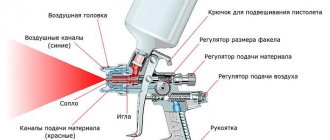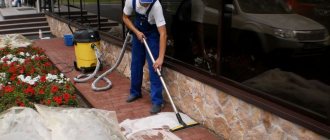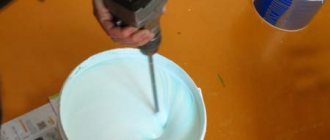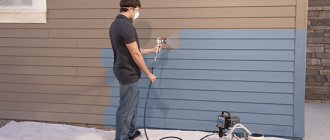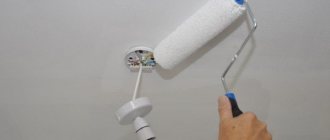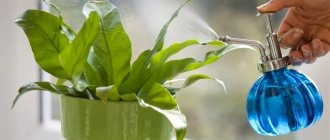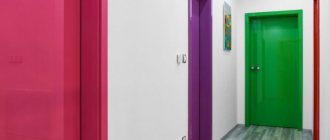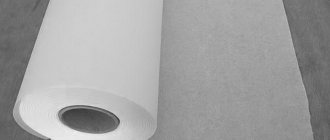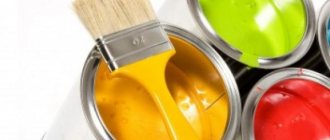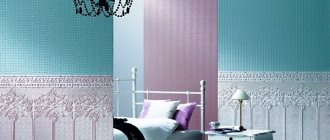As with any equipment, you should use a spray gun no earlier than a specialist becomes familiar with the safety precautions for the work being performed. It is important to remember the following recommendations:
- When working indoors, it is necessary to ensure the presence of supply and exhaust ventilation.
- Air humidity is an important criterion, since working with such a tool outdoors begins only in dry, windless weather.
- Before starting work, you must make sure that there is paint in the barrel of the device.
- When diluting paint, we follow the instructions issued by the manufacturer.
- The lid of the spray gun can must be tightly closed.
Painting walls with a spray gun
The best option for working with such a device is to work in pairs - in this case, one person will provide direct painting, and the second will take care of maintaining optimal pressure in the tank. Thus, the resulting layer of paintwork will be free of defects - drips, bald spots and stains.
Types of spray guns and their differences
Before we talk about how to use a spray gun, let's figure out what they can be and what they are used for. First of all, they are intended for applying paint and varnish material, but the applicability of paintwork materials by type and the quality of work will differ.
Pneumatic spray gun
Painting with a pneumatic spray gun Source 1pofasadu.ru
The most popular type of spray gun in a professional environment. It works in combination with a compressor that delivers the required pressure. It features high-quality results. The operating principle is based on feeding paintwork materials into a nozzle through which a powerful air flow passes. Upon meeting, it breaks the paint structure into fine dispersed dust and sprays through the so-called torch.
Pneumatic sprayers can be with an upper or lower location of the working container. The remaining design features on most models are almost identical.
Healthy! The advantage of such spray guns is the minimal consumption of paint, which is applied in a thin and even layer.
Technology of painting the ceiling with a spray gun
The scheme for painting a ceiling with a spray gun looks simple, but execution requires care and diligence. After the composition is poured into the tank and the wall is prepared for work, you can begin to directly apply the paint.
The face must be protected from contact with the substance, especially the eyes and nose.
Hold the spray gun perpendicular to the ceiling, spray at a distance of 30-50 cm. It is convenient to mentally divide the surface into hand-length squares and paint them one by one. It is very important to maintain the same pace so that the layer turns out uniform. At first the direction can be from left to right, then from top to bottom. Alternating longitudinal and transverse movements will help to obtain an even layer.
It is recommended to apply water-based paint in 2-3 layers so that the color is dense in color. Before applying a new layer, the previous one must be completely dry! The high speed of the spray gun is widely used, which is why it is also used for applying whitewash. The technology is no different from ordinary paint. After drying, you can remove sagging and unevenness by carefully sanding them.
How to use a spray gun
Surface painting using an electric or pneumatic spray gun is carried out in the following sequence:
- Preparing the base. At this stage, the surface is cleaned of the old layer of paint and rust, plastered, primed, degreased, and dried. Other preparatory work is carried out, the order and duration of which are assessed individually.
- Preparation of paint solution. The viscosity of the composition is selected according to the recommendations of the tool manufacturer. The viscosity must correspond to the nozzle diameter.
Healthy! Most kits have a special measuring funnel for this purpose. With its help, you can easily and quickly determine the fluidity of the paint and varnish material. It’s quite simple to use: you need to pour the specified amount of diluted paint and time how long it takes for it to flow out of it.
- Inspection and assembly of the spray gun and test painting with assessment of the quality of the resulting surface.
- The main stage of applying paint.
- Cleaning the instrument. A crucial point, ignoring which will lead to the unusability of the spray gun.
What is a mechanical method of painting surfaces with paint?
Page navigation
Mechanized paint application involves the use of a special sprayer. The spray gun is most often used to treat large surfaces.
The mechanical method is used for painting and priming surfaces in apartments, houses, hangars and warehouses, offices, and parking lots. This method is especially justified when processing outbuildings, building facades, fences and other large objects.
A paint sprayer is an expensive piece of equipment that requires certain operating skills, so when choosing this painting method, it is better to seek the services of professionals.
Advantages
Mechanized painting has a number of advantages:
- high processing speed - up to 150 m2 per hour;
- economical paint consumption - about a quarter less than with any other method;
- uniformity of the resulting coating - thorough painting without streaks or missing spots;
- no hard-to-reach places - spray paint perfectly fills any shape.
Flaws
Disadvantages of using a spray gun:
- noise of the operating device;
- the high cost of purchasing or renting equipment, which is only advisable if it is necessary to paint a large area of surfaces;
- operation on electricity, which can be a hindrance in a new building with an unstable network or forced outages.
General view and design of the tool
Before using a spray gun, you should understand its design. As mentioned earlier, the design of electric and pneumatic devices is almost the same. Therefore, let’s consider the situation on one of the most popular versions designed to work with a compressor.
General view and design of the instrument Source instrumentoria.ru
What are you going to paint?
When choosing a spray gun, specialization plays a big role. Not all devices will cope equally well with your task, so be sure to ask the seller about the equipment parameters and the range of possible settings. Important selection criteria are:
- Electric motor power;
- Tank location: top, bottom;
- Paint tank volume;
- Paint viscosity allowed for this device;
- Parameters of the working torch.
For finishing work, it is better to choose powerful spray guns with large capacity tanks. If equipment is purchased for painting small objects, then it is better to give preference to the “desktop” version with a compact container for painting material, a small but “sharp” torch and a set of replaceable nozzles.
Manual
Regularly check the tightness of bolted connections before starting work. This primarily concerns the adjusting screws and the air intake nut. Repairs and maintenance are carried out only with the device de-energized. Violation of safety precautions can lead to serious consequences.
The procedure for working with a spray gun begins with preparing the device for the task. To do this you will need:
- Set the nozzle to the desired size.
- Blow out and make sure the air supply hose is intact. Use it to connect a compressor with a spray gun.
- Turn on the device and select the appropriate shade, adjust the air supply, paint and torch width. This is done not on the surface being processed, but on a template. It is recommended to start painting only after all the mentioned settings have been completed.
How to work with a spray gun correctly Source evrotek.spb.ru
To prevent overspray, keep the distance between the torch and the surface to be treated in the range of 15-25 cm. You need to spray the composition evenly, moving the spray gun perpendicular to the surface, as shown in the image.
The answer to the question of how to use a spray gun correctly will remain incomplete if we do not mention the mandatory cleaning of the tool after completion of work. Cleaning is carried out with a solvent, white spirit, solvent or other composition with similar characteristics. To do this, unscrew all elements that come into contact with the coloring composition and rinse them thoroughly. The easiest way to clean a spray gun is to bathe it in a solution poured into a small container (on average, it takes about 300-400 g of white spirit to wash a tool).
Complete disassembly and cleaning of the spray gun Source kraskistroi.ru
Healthy! Before taking our advice, carefully read the instruction manual for your device. Some manufacturers categorically do not recommend putting the gun in solvent.
Hardened areas are rubbed off manually. It is not recommended to use hard objects for these purposes. To clean the nozzle nozzles, you can use needles whose cross-section corresponds to the diameter of the holes.
Important! Rinse the spray gun immediately after completing paint work (before the paint begins to harden) and never leave it soaked in solvent or its analogues.
Mechanized painting: how to apply paint
Mechanized painting devices differ in the spraying method:
- Pneumatic spray. The essence of the device is to crush a stream of paint into tiny droplets with a stream of air. Air spray guns of this type are divided into three types of international designations:
- HP (High Pressure), or conventional, transfers 30-45% of the paint and varnish material to the surface while the rest settles on the floor. International markings are white or silver.
- HVLP (High Volume Low Pressure) transfers the dye in an amount of about 70% and is marked in green.
- LVLP (Low Volume Low Pressure) is a device with improved operating pressure and compressor performance, which allows it to transfer up to 90% of the paint to the surface. Marking is blue.
- Airless spray. The process occurs due to the pressure difference at the outlet of the paint from the nozzle. Airless spray guns provide the highest percentage of paint transfer to the surface, but require expensive components (pumping station, hoses, nozzles) and their thorough and labor-intensive washing.
- Combined spraying. Distributes paint most evenly, combining airless crushing and dosed air flow at low pressure. The advantages of the method are less loss of dyes and greater flexibility of the sprayer, but a significant disadvantage is the high cost of the necessary compressors - piston and air.
Preparing the paint
A small electric spray gun for the home Source i1.wp.com
A feature of spraying paint with a spray gun is the strict requirements for the composition used. The consistency must have the viscosity declared by the tool manufacturer. Too thick a composition will lead to uneven distribution, increased drying time and waste of material. When applied to inclined or vertical surfaces, this will negatively affect the quality of the paint. Microcracks and roughness will be unevenly covered.
Paint diluted very thinly will not be able to completely cover the surface and will require a second coat. The result will be an increase in the volume and time spent on work.
To achieve the specified thickness of the paint and varnish material, a liquid recommended by the paint and varnish manufacturer is added to it. It can be a solvent, white spirit, gasoline, solvent, water.
Important! The type of paint thinner for the spray gun is selected in accordance with the paintwork material used.
Technique for applying paint to the wall
Painting walls with an electric spray gun using water-based paint is carried out from top to bottom. First you need to go through the surface under the ceiling, gradually moving down. The distance from the tool to the wall should be at least 30 cm. Trying to maintain the set pace, walk the entire wall in one direction and let the layer dry. Apply the paint again (after the wall has dried), but in a perpendicular direction. You should not linger in one place so as not to get a thick stain in the middle of the wall.
Only after drying can you remove the masking tape - otherwise it is easy to damage the freshly painted layer. You must not forget about the instrument - it should be washed with water or solvent. The liquid is poured into the tank and driven through the sprayer.
Painting walls and ceilings with a spray gun saves a lot of time compared to traditional methods. You just need to do the preparatory work and mix the paint correctly. Out of habit, a spray gun may seem like a complicated tool, but after a few minutes of working with it, you will gain confidence. They can carry out high-quality painting of walls with any paint, even without the skills of a painter.
Features of working with a spray gun
Standard set for a compressor Source kontrast-kraski.ru
Using a spray gun, you can spray various types of paints and varnishes: oil, latex, acrylic, alkyd and other types of paints. The only condition that must be met is the fluidity of the composition. Its value is selected individually, depending on the characteristics of the instrument. You can find the exact value for each model in the instruction manual.
The spray gun trigger is pressed evenly Source vmirekraski.ru
How the principle of collecting paint in a spray gun is constructed Source idoallsam.ru
In addition, when working with a spray gun, you should pay attention to a number of other equally important aspects:
- When carrying out interior work, you need to prepare the room for painting: close or remove interior items that cannot be painted. When covering, secure the material with masking tape.
- The composition should be sprayed so that spilled drops and particles flying past the surface to be painted do not fall on those that remain uncovered.
- When working outside, choose a position based on the wind and its possible gusts.
- It is recommended to use personal protective equipment when working with a spray gun: gloves, goggles, respirator.
- When using stagnant paint, strain it through cheesecloth. This will clear the composition of lumps that can cause clogging of the instrument.
- Do not apply copious amounts of paint at once. This will cause the formation of streaks and drops.
- Each subsequent row slightly overlaps the previous one, which minimizes the likelihood of unpainted areas.
- The second and subsequent layers are applied after the previous one has completely dried (the duration depends on the temperature conditions and the type of paint used).
Advice! If you do not have experience with a spray gun, start painting from the “back”, “less noticeable, significant” area. Don't touch the front one yet. During the course of the work, you will gain certain skills and be able to create a higher-quality coating than at the very beginning of painting (on the “less significant side”).
How a spray gun works Source avtograph-oem.ru
What difficulties may arise when using a spray gun?
The appearance of drips - especially often such defects appear at the edges, which is due to weak air flow.
In order for the wall decoration to be beautiful, it is necessary to use the spray gun correctly. Therefore, we will consider the main problems faced by users of such equipment.
- If the painted surface does not produce an even and beautiful layer, it is worth changing the distance from the sprayer to the wall - on average it should be from 15 to 30 cm. Alternatively, you may need decorative spraying - in this case it is better to increase the distance. Painting should begin not from the wall, but from a piece of cardboard or wood. Test painting will allow you to adjust the operation of the nozzle and evaluate the paint layer when moving the spray gun in different directions. After such preparation, you can start working.
- The appearance of drips - especially often such defects appear at the edges, which is due to weak air flow. This error can be eliminated by reducing the intensity of the air flow; alternatively, you can choose a paint with a lighter composition.
- Streaks along the central part of the wall are a consequence of too much paint flow. To adjust the situation, it is recommended to reduce the flow through the nozzles or increase the air stream.
- The layer after painting looks dusty - this is a consequence of the high viscosity of the paintwork. It is necessary to adjust the composition, making it more liquid. Add solvent in small portions, checking the consistency using a test stain.
- To be able to use the spray gun, you must constantly take care of its cleanliness; we clean the equipment after each painting. Otherwise, the remaining paint will simply dry in the sprayer channels and it will be simply impossible to remove them from there. Even small paint residues in the channels are undesirable, since over time they peel off and end up on the painted surface, causing defects in the paintwork.
When used correctly, the spray gun allows you to save paint and also significantly speed up repairs. In this case, you can use a variety of models of spray guns, the main thing is to choose paint with a suitable density, adjust the torch, air flow and jet, which will ensure an even coating of the wall being painted without traces of dust and streaks.
Which roller should I use to paint the walls?
Creating a tinted wall or textured design is entirely dependent on the roller attachment. When the question of what the room should be like is decided, the type of painting is chosen. Accordingly, a roller with the necessary attachment is selected .
When determining the type of painting, there are several types of rollers. They can create incredible backgrounds, scenes, textures:
- To paint a smooth surface (ceiling, background or bottom layer of a textured or structured pattern), you need to select a roller with the thinnest pile or a simple, soft, lint-free one;
- To paint relief surfaces or textures (curly colored wallpaper or decorative figures made on the wall using putty or plaster), it is necessary to select rollers with large piles.
- When creating a texture on the walls, it is necessary to select rollers whose nozzles contain decorative elements (this can be various paddings, stripes, rubber pads with a ready-made pattern). By rolling out the roller strictly in one direction, aesthetic elements are obtained.
They are able to paint over all hidden areas of reliefs on the wall;
Popular models
There are many different spray guns for facade paint from popular manufacturers. Each manufacturer often has its own equipment. Sometimes there are auxiliary devices: fittings, filters, stands, gaskets, and so on.
Let's get acquainted with popular manufacturers:
- Sata. The brand produces popular household and professional models of spray guns. These are high-quality models with an even and uniform torch. Thanks to the quality of paint transfer, they have proven themselves in work with facades.
- Walcom. The devices produced by this company are used for finishing painting, and therefore are often found in industrial sectors. This is a high category technique that has passed many tests. Each model produced has a gearbox, a pressure gauge and a filter for cleaning paint, not to mention gaskets and springs. The buyer will also be pleased with other additional items included in the package: lubricating oil, cleaning brush, keys for service.
- Bosch. This is a manufacturer of household appliances that offers spray guns that will quickly and efficiently apply paint to the surface being treated. The equipment is suitable for both industrial and household finishing work. Due to the versatility of the devices, they are suitable for spraying even particularly thick formulations. There is a built-in system necessary for recording and adjusting fluid flow. A special support surface ensures stability during operation.
- Wagner. This company produces highly specialized devices - powerful and convenient spray guns. They have proven themselves both in industry and in everyday life, and both beginners and professionals can handle them.
A properly selected spray gun will ensure high-quality and convenient painting of the required surface. At the moment, several types of this equipment are produced, so everyone can choose a device to suit their needs.

